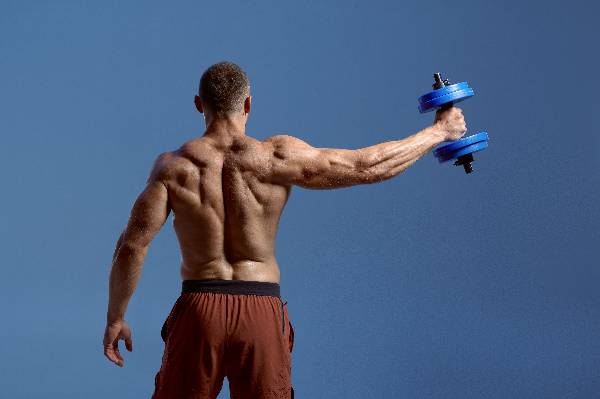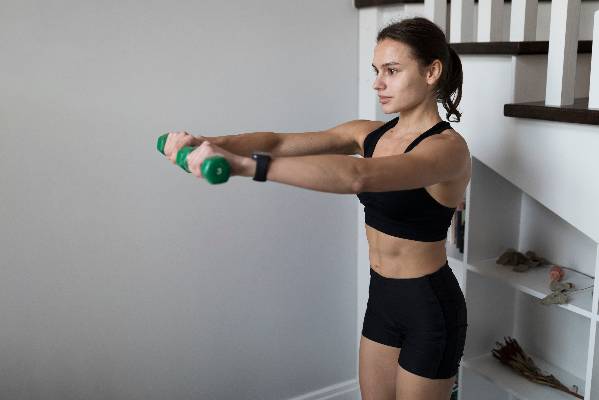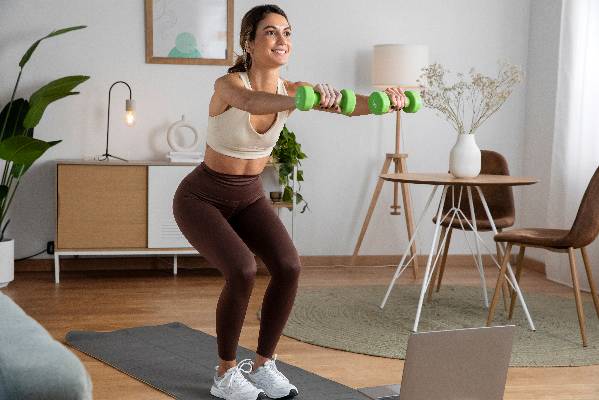Rear Deltoid Workout Using Dumbbells
Introduction to the Rear Deltoid Muscle
Are you looking to sculpt strong shoulders and enhance your overall physique? The rear deltoids are often the unsung heroes of shoulder development. While most people focus on their front delts, neglecting the rear can lead to muscle imbalances and poor posture. A well-rounded shoulder routine not only improves your appearance but also boosts your strength in various lifts. If you’re ready to take your training to the next level, a targeted rear deltoid workout using dumbbells is just what you need! Let’s dive into everything from anatomy to essential exercises that will help you build those elusive rear delts effectively.
Benefits of Strong Rear Deltoids
Strong rear deltoids play a crucial role in overall shoulder health. They help maintain proper posture by counteracting the forward pull of stronger chest muscles. This balance reduces the risk of injuries and discomfort.
Enhanced shoulder stability is another key benefit. Well-developed rear deltoids improve coordination during various upper body movements, making daily activities easier and more efficient.
Aesthetically, strong rear deltoids contribute to a well-rounded physique. They create width across the shoulders, giving an impressive V-shape appearance that many fitness enthusiasts strive for.
In athletic performance, powerful rear delts can boost your game. Whether you’re throwing a ball or lifting weights overhead, these muscles support explosive movements and enhance endurance.
Training your rear deltoids helps prevent imbalances that can lead to chronic pain or injuries over time. Prioritizing this often-overlooked muscle group pays off in both functionality and aesthetics.
Basic Anatomy of the Rear Deltoid Muscle
The rear deltoid muscle, or posterior deltoid, plays a vital role in shoulder function. It is located at the back of your shoulder and connects to the scapula.
This muscle originates from the spine of the scapula and inserts into the humerus. Its primary function is to facilitate shoulder extension, external rotation, and horizontal abduction.
Understanding its anatomy helps you target it effectively during workouts. The rear deltoid works alongside other muscles like the trapezius and rotator cuff muscles for balanced movement.
Developing this area can improve overall shoulder stability and enhance posture. This knowledge sets a solid foundation for incorporating targeted exercises into your routine.
Essential Dumbbell Exercises for the Rear Deltoids
To effectively target the rear deltoids, several dumbbell exercises stand out. Each of these movements engages this crucial muscle group while promoting shoulder stability.
Reverse Flys are a staple in any rear delt workout. By bending slightly at the hips and extending your arms outward with dumbbells, you create tension that feels rewarding. This exercise mimics the motion of spreading wings, emphasizing shoulder retraction.
Bent-Over Flys add variety and depth to your routine. With a slight bend in both knees, hinge forward from the hips as you lift weights laterally. This position not only isolates the rear delts but also helps develop overall back strength.
Lateral Raises aren’t just for side muscles; they can be modified to emphasize the rear deltoids too. Raise your arms with palms facing down until they’re parallel to the ground while maintaining an open posture throughout your shoulders.
Incorporating these exercises will ensure balanced development of your shoulder muscles!
A. Reverse Flys
Reverse flys are a fantastic exercise for targeting the rear deltoids. They engage the upper back and improve shoulder stability, making them an essential movement in any rear deltoid workout using dumbbells.
To perform reverse flys properly, start by standing with your feet shoulder-width apart. With a dumbbell in each hand, bend slightly at the hips while keeping your back straight. Your arms should hang down directly from your shoulders.
As you lift the weights, focus on squeezing your shoulder blades together. This action activates the rear deltoids effectively. Aim for controlled movements rather than swinging or using momentum.
You can also do reverse flys seated or bent over to vary the intensity and angle of resistance. Adjusting these factors keeps your muscles engaged and challenged throughout your workouts.
B. Bent-Over Flys
Bent-over flys are a fantastic way to target the rear deltoids. This exercise effectively isolates these muscles, ensuring they get the attention they deserve.
To perform bent-over flys, start by standing with your feet shoulder-width apart. Bend slightly at the knees and hinge forward at the hips while keeping your back straight. Make sure you maintain a neutral spine throughout the movement.
With dumbbells in hand, let your arms hang down towards the floor. As you raise both arms out to the side, focus on squeezing those shoulder blades together. This motion not only engages your rear deltoids but also activates other upper back muscles.
Aim for controlled movements rather than swinging through them. Keep your core tight to stabilize your body during this exercise and avoid unnecessary strain on your lower back. Remember that quality matters more than quantity when it comes to seeing results from bent-over flys.
C. Lateral Raises
Lateral raises are a fantastic exercise for targeting the rear deltoids while also engaging the side delts. This move is simple but highly effective when performed correctly.
To execute lateral raises, start by standing tall with a dumbbell in each hand. Keep your feet shoulder-width apart and let your arms hang naturally at your sides. As you lift the weights, ensure that your elbows remain slightly bent and lead with them rather than your hands.
Focus on raising the dumbbells to shoulder height or just above, then slowly lower them back down. Control is key; avoid swinging or using momentum to lift the weights.
Aim for higher reps to really feel those muscles working. It’s not just about building strength; it’s about enhancing stability and posture too. Incorporating lateral raises into your routine can help round out shoulder development beautifully.
Sample Workout Routine
Creating an effective rear deltoid workout using dumbbells is crucial for balanced shoulder development. Here’s a sample routine to get you started.
Begin with reverse flys. Perform three sets of 10-15 reps, focusing on squeezing the shoulder blades together at the top of each movement. This will activate those rear delts effectively.
Next, move into bent-over flys. Aim for three sets of 10-12 reps here as well. Keep your back straight and hinge at the hips to maximize engagement.
Finish off with lateral raises. These target not only the rear deltoids but also help in developing overall shoulder strength. Three sets of 12-15 reps should suffice.
Remember to rest for about one minute between sets to maintain form and intensity throughout your session. With consistent practice, you’ll soon notice significant improvements in strength and definition in your shoulders.
Tips for Proper Form and Technique
Maintaining proper form is crucial for any rear deltoid workout using dumbbells. Start by positioning your feet shoulder-width apart, grounding yourself to ensure stability.
When performing exercises like reverse flys, hinge at the hips while keeping a flat back. This prevents undue strain on your lower back and focuses the effort on your shoulders.
Keep your elbows slightly bent throughout movements—this reduces joint stress and enhances muscle engagement.
Slowly lift the weights in a controlled manner; avoid swinging or using momentum, which can compromise technique and effectiveness.
Always engage your core to support your spine during each rep. This not only aids balance but also maximizes muscle activation in targeted areas. A mindful approach leads to better gains and reduces injury risk significantly.
Common Mistakes to Avoid
When working on your rear deltoids, avoiding common mistakes can make all the difference. One frequent error is using weights that are too heavy. This often leads to poor form and reduced effectiveness.
Another mistake is neglecting proper shoulder positioning. Keep your shoulders down and away from your ears throughout the exercises to prevent strain.
It’s also crucial not to rush through each movement. Slow, controlled motions engage the muscles more effectively and reduce injury risk.
Many lifters forget to integrate a balanced routine targeting all aspects of shoulder development. While focusing solely on rear delts is essential, don’t overlook front and lateral raises for overall strength.
Varying angles during workouts can help target different parts of the muscle better. Sticking with just one exercise may limit growth potential over time. Be mindful of these pitfalls as you enhance your training regimen.
How Often to Train the Rear D
Training the rear deltoids is crucial for balanced shoulder development. To achieve optimal results, aim to incorporate a rear deltoid workout using dumbbells into your weekly routine two to three times. This frequency allows for adequate recovery while promoting muscle growth.
Pay attention to how your body feels after each session. If you experience excessive soreness or fatigue, consider adjusting the volume or intensity of your workouts. Remember that rest days are just as important as training days; they allow your muscles time to repair and grow stronger.
Consistency will yield better results over time. As you progress, gradually increase weights or repetitions to continue challenging yourself and enhance strength in those often neglected muscles. With dedication and proper technique, you’ll not only improve the aesthetics of your shoulders but also enhance overall upper body performance.
- About the Author
- Latest Posts
Johnnie D. Jackow Sr., the founder and CEO of Total Body Fitness, Worldwide, has a long-standing career in the fitness industry. He began as a certified personal trainer in the mid-90s and soon after authored his first weight loss book in 1998. This led to the launch of Total Body Fitness, Nationwide in the USA at the same time. Johnnie gained recognition as the fitness guru of his time, running infomercials on local TV late at night in Houston, Texas. Over the years, he has helped more than 40,000 individuals from all over the world achieve their health and fitness goals. With over 60,000 hours of documented training in integrative functional medicine, he completed his PhD in human physiology in 2010. His primary objective is to assist people in reaching their health and fitness goals through alternative approaches rather than relying solely on conventional medicine and pharmaceutical drugs. Today, with almost three decades of experience under his belt, Johnnie continues to be a leader in health and fitness.








